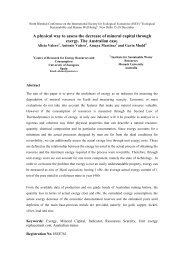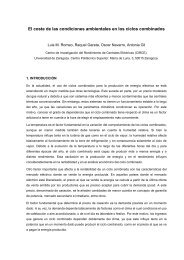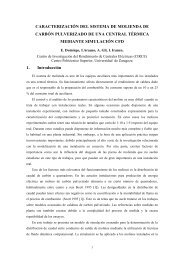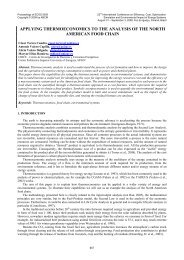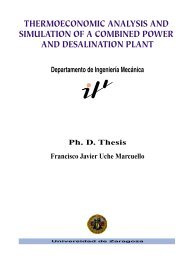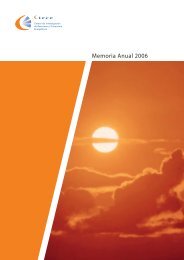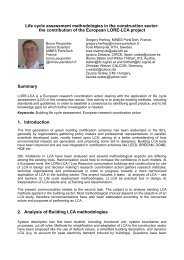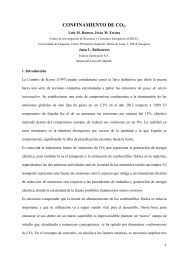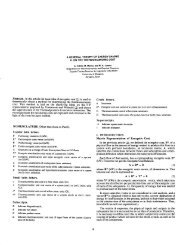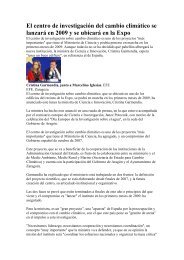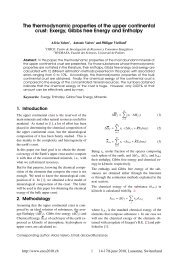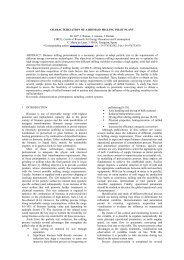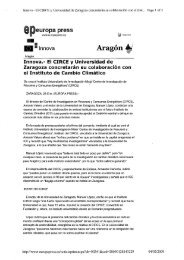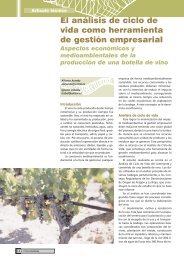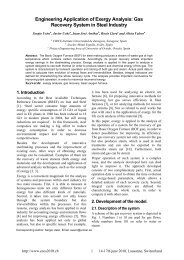towards an international legal reference environment
towards an international legal reference environment
towards an international legal reference environment
You also want an ePaper? Increase the reach of your titles
YUMPU automatically turns print PDFs into web optimized ePapers that Google loves.
Hence the import<strong>an</strong>ce of <strong>an</strong> appropriate selection of<br />
a R.E. for evaluating natural resources.<br />
SEARCHING THE BEST SUITABLE R.E.<br />
CATEGORY<br />
So far, there have been m<strong>an</strong>y contributions to the determination<br />
of a R.E. They could be divided into two<br />
main groups: Partial <strong>an</strong>d Comprehensive Reference<br />
Environments.<br />
It is well known, that some authors such as Bosnjakovich<br />
[4], Gaggioli <strong>an</strong>d Petit [5] <strong>an</strong>d Sussm<strong>an</strong><br />
[6] established that the R.E. should be defined according<br />
to the specific characteristics of the <strong>an</strong>alyzed<br />
process. This criterion is based on that being<br />
the exergy a parameter that qu<strong>an</strong>tifies the theoretical<br />
evolution of a system with respect to the R.E., some<br />
of the possible evolutions of the system, c<strong>an</strong>not be<br />
attained because of process limitations. Hence, only<br />
possibilities of evolution that the system c<strong>an</strong> practically<br />
attain are <strong>an</strong>alyzed. The R.E. is not a “dead<br />
state” <strong>an</strong>ymore. For computing exergy ch<strong>an</strong>ges of<br />
variable composition or chemically reactive steady<br />
flow processes, a Comprehensive Reference Environment<br />
is generally unnecessary. However, this is<br />
not the case when the point is to evaluate the natural<br />
capital on Earth. In this case, there are no process<br />
limitations <strong>an</strong>d the resources c<strong>an</strong> follow <strong>an</strong> evolution<br />
process <strong>towards</strong> the dead state, thus a comprehensive<br />
R.E. is required.<br />
Within the known Comprehensive Reference Environments,<br />
all authors agree in dividing the Reference<br />
Subst<strong>an</strong>ces (R.S.) that compose the R.E. into<br />
gaseous components of the atmospheric air, solid<br />
components of the external layer of the Earth’s crust,<br />
<strong>an</strong>d molecular components of seawater. Nevertheless,<br />
there are also criterion differences between the<br />
different authors. They could be classified into <strong>environment</strong>s<br />
based on 1) Szargut’s criterion, 2) Chemical<br />
equilibrium <strong>an</strong>d 3) Abund<strong>an</strong>ce.<br />
Abund<strong>an</strong>ce <strong>an</strong>d Szargut’s criterion are not opposite<br />
criteria. According to Szargut’s criterion, among a<br />
group of reasonable abund<strong>an</strong>t subst<strong>an</strong>ces, the most<br />
stable will be chosen if they also complain with the<br />
“Earth similarity criterion”. That is, if the stability<br />
of the possible different <strong>reference</strong> subst<strong>an</strong>ces for a<br />
specific element (measured in terms of the formation<br />
Gibbs energy) is within a certain threshold, then<br />
the most abund<strong>an</strong>t R.S. will be chosen. If the differences<br />
exceed this threshold, the most stable sub-<br />
st<strong>an</strong>ce will be taken as R.S. as long as it does not<br />
contradict the “Earth similarity criterion”. The stability<br />
threshold has not a fix value <strong>an</strong>d depends on<br />
each element considered, since it is subjected to geological<br />
uncertainties. Thus for example in the case<br />
of Sb, the subst<strong>an</strong>ce Sb2S3 is more abund<strong>an</strong>t th<strong>an</strong><br />
Sb2O5, nevertheless, according to Szargut’s criterion,<br />
Sb2O5, which is much more stable, will be<br />
taken as <strong>reference</strong> subst<strong>an</strong>ce. This happens also with<br />
the subst<strong>an</strong>ces listed in table 1. Nevertheless nitrates<br />
such as Ca(NO3)2, NaNO3, KNO3 are discarded,<br />
because being most stable but not abund<strong>an</strong>t<br />
in the natural <strong>environment</strong>, would break the similarity<br />
criterion if they are taken as R.S. Therefore,<br />
Szargut’s [7] dead <strong>environment</strong> is similar to the real<br />
physical <strong>environment</strong> <strong>an</strong>d should represent the products<br />
of <strong>an</strong> interaction between the components of<br />
the natural <strong>environment</strong> <strong>an</strong>d the waste products of<br />
the processes. The most probable products of this<br />
interaction should be chosen as <strong>reference</strong> species.<br />
Next section explains purposively the well known<br />
Szargut’s methodology for obtaining the chemical<br />
exergy of the elements from the R.E.<br />
Some authors define the chemical exergy by me<strong>an</strong>s<br />
of the chemical equilibrium with the real <strong>environment</strong>.<br />
Szargut stresses that it is not possible to attain<br />
<strong>an</strong> equilibrium with the system being not in the state<br />
of internal equilibrium (<strong>an</strong>d the natural <strong>environment</strong><br />
is far away from such equilibrium). Ahrendts [8]<br />
<strong>an</strong>d Diederichsen [9] for example, stated that if<br />
the amount of different elements in the <strong>reference</strong><br />
system is known <strong>an</strong>d the temperature of the system<br />
is fixed, the qu<strong>an</strong>tity of each chemical compound<br />
<strong>an</strong>d the value of each chemical potential is<br />
uniquely determined by the condition of chemical<br />
equilibrium. Even though Ahrendt’s R. E. only included<br />
15 elements, they represented more th<strong>an</strong> 99%<br />
of the Earth’s crust <strong>an</strong>d thus his R.E. c<strong>an</strong> be considered<br />
as a Comprehensive Reference Environment.<br />
Ahrendts calculated the composition of this <strong>environment</strong><br />
in chemical equilibrium, having as a variable<br />
parameter the thickness of the crust layer.<br />
Valero, R<strong>an</strong>z <strong>an</strong>d Botero [2], explained already why<br />
Ahrendt’s R.E. was not suitable to evaluate the natural<br />
capital on Earth. Most of the metals c<strong>an</strong>not<br />
be evaluated because they form part of the 1% of<br />
the Earth’s crust neglected by Ahrendts. His obtained<br />
R.E. is very different from the real <strong>environment</strong><br />
<strong>an</strong>d it is very unlikely <strong>an</strong> eventual evolution



